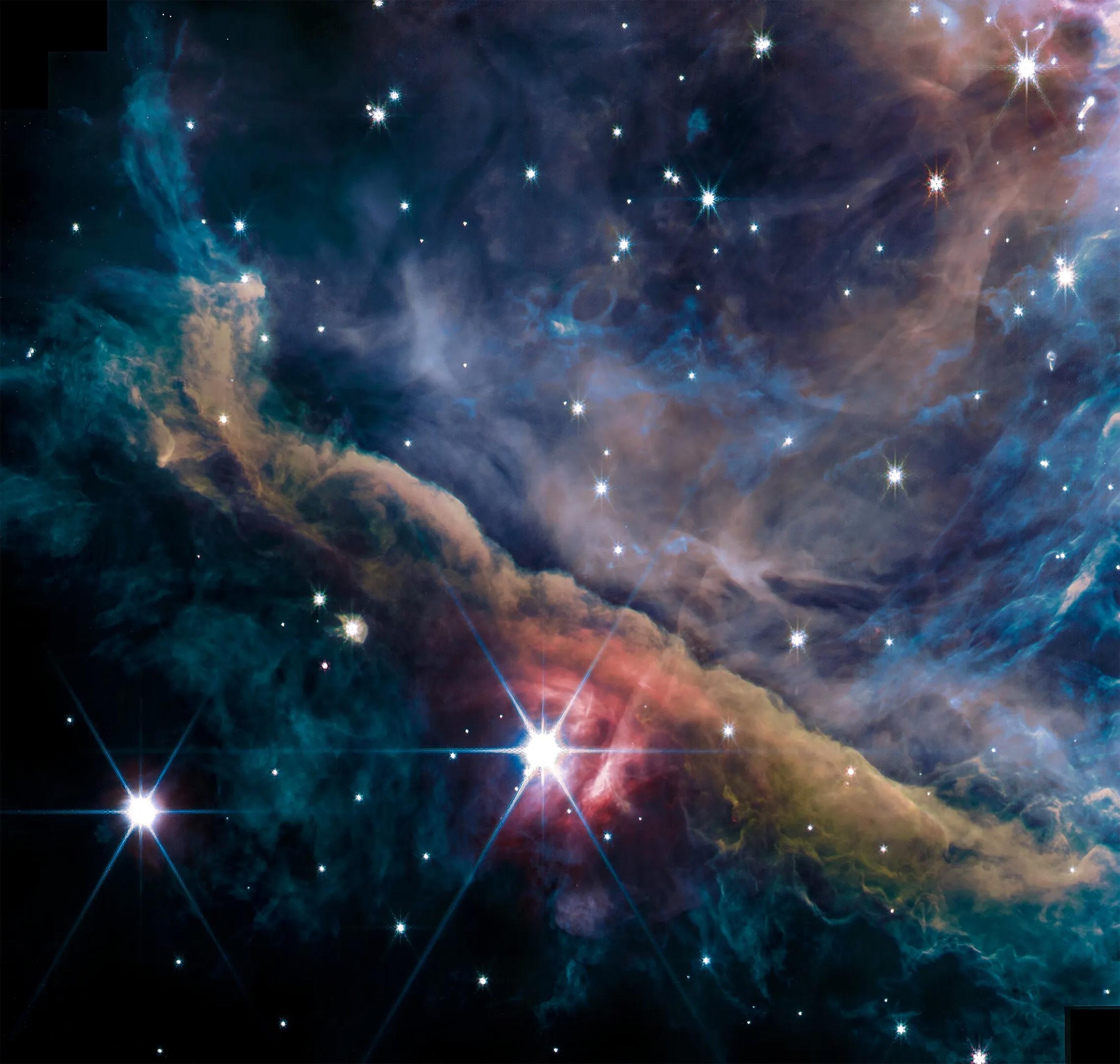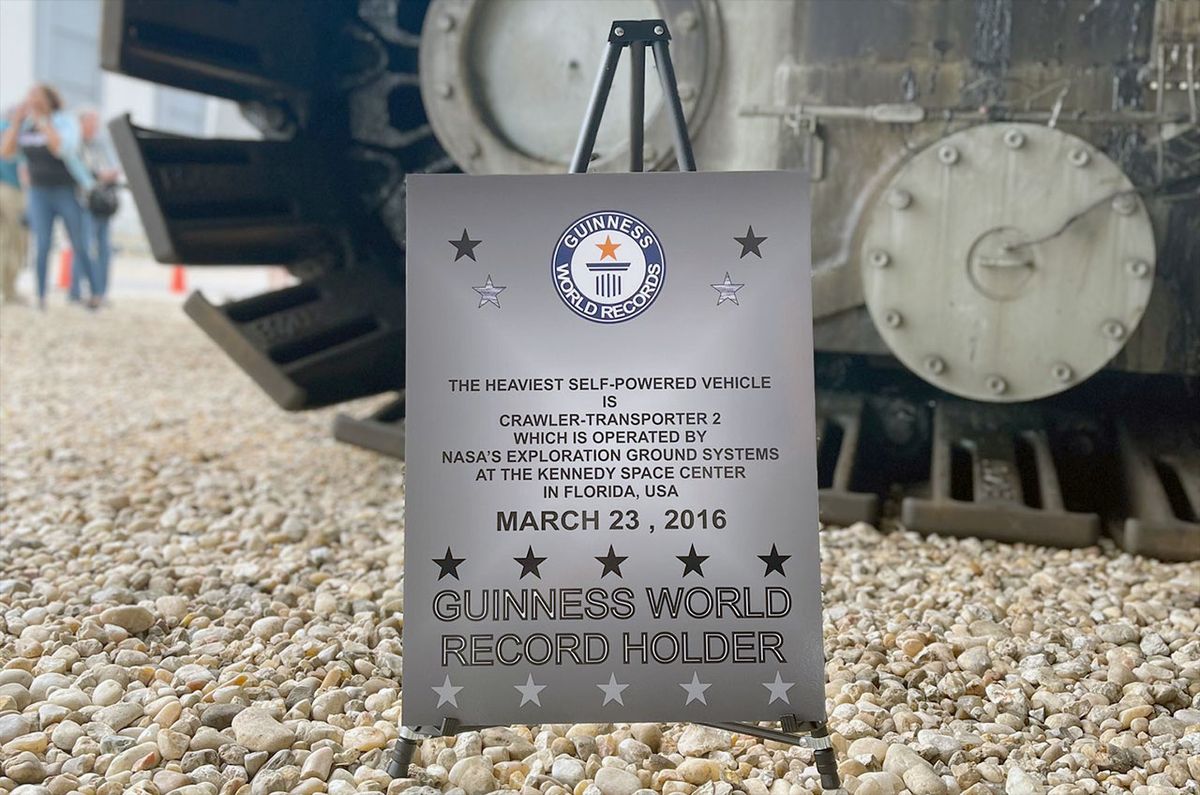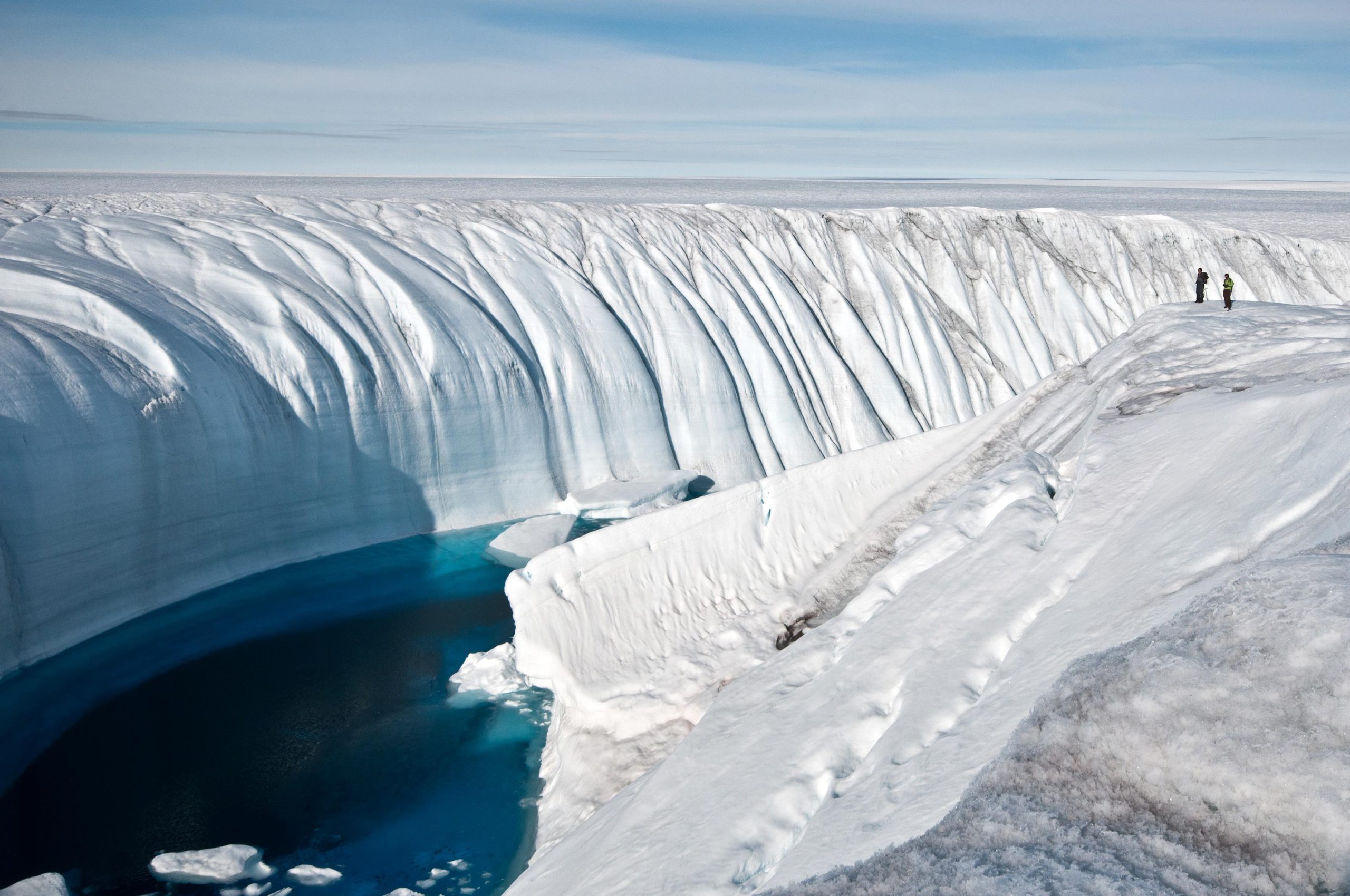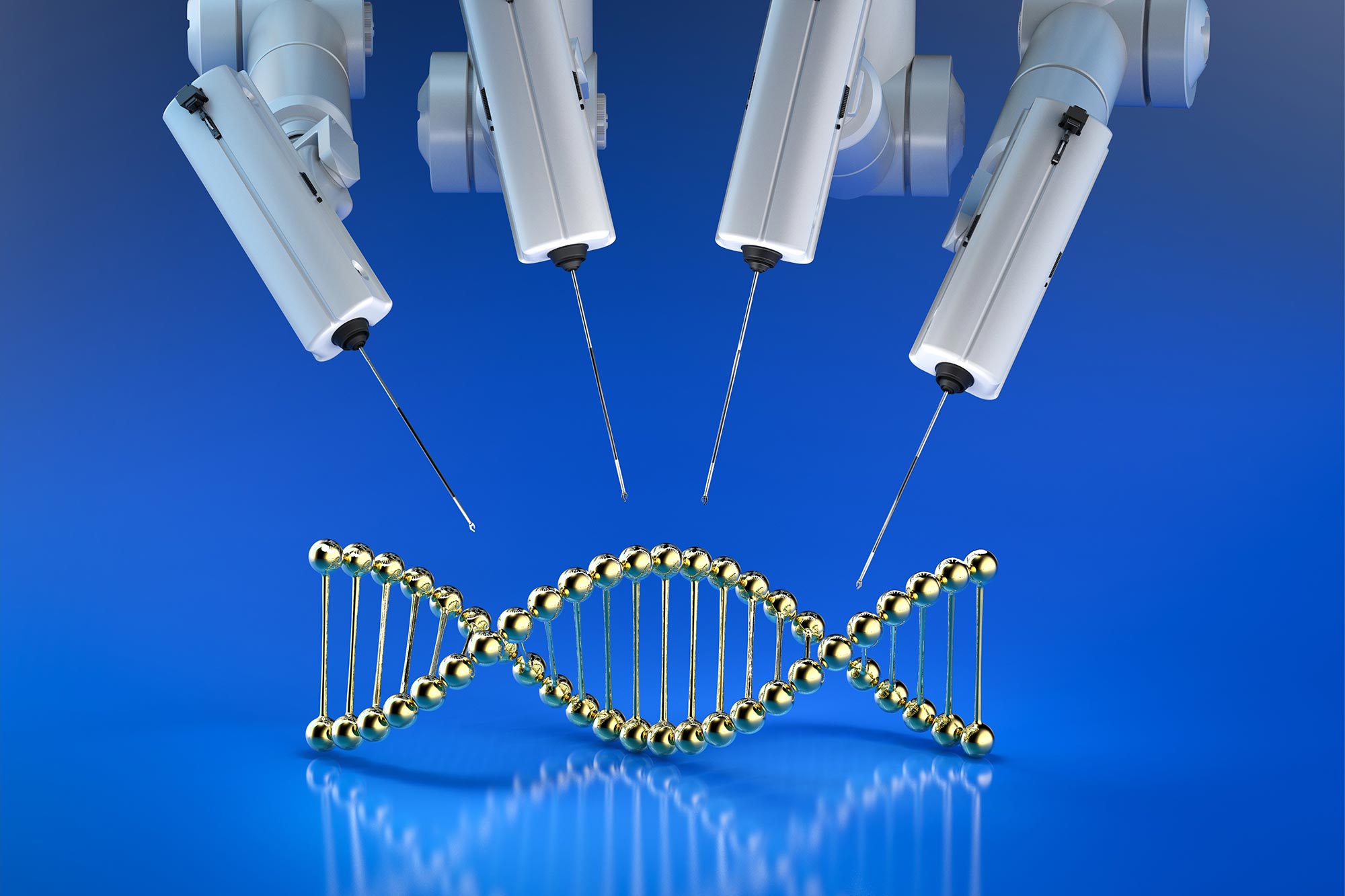Primeras impresionantes imágenes del telescopio espacial Web de los astrónomos de la Nebulosa de Orión

El interior de la Nebulosa de Orión visto por el instrumento NIRCam del Telescopio Espacial James Webb. Esta es una imagen compuesta de varios filtros que representan emisiones de gas ionizado, gas molecular, hidrocarburos, polvo y luz estelar dispersa. La más notable es la barra de Orión, una pared de gas y polvo espeso que se extiende desde la parte superior izquierda hasta la parte inferior derecha de esta imagen, que contiene la estrella brillante θ.2 Orionis A. La escena está iluminada por un grupo de estrellas masivas jóvenes y calientes (conocidas como el cúmulo del trapecio) justo en la parte superior derecha de la imagen. Los fuertes y duros rayos UV de la matriz Trapezium crean un entorno ionizante caliente en la parte superior derecha, erosionando lentamente la barra de Orión. Las partículas y el polvo pueden sobrevivir más tiempo en el entorno protegido proporcionado por la densa cinta, pero el estallido de energía estelar talla una región que muestra una asombrosa riqueza de filamentos, glóbulos y estrellas jóvenes con discos y cavidades. Crédito: NASA, ESA, CSA, Reducción y análisis de datos: Equipo PDRs4All ERS; S. Fuenmayor .tratamiento gráfico
Nuevas imágenes web revelan una vista asombrosa de la Nebulosa de Orión
“We are blown away by the breathtaking images of the Orion Nebula. We started this project in 2017, so we have been waiting more than five years to get these data,” said Western astrophysicist Els Peeters.
These images have been obtained as part of the Early Release Science program Photodissociation Regions for All (PDRs4All ID 1288) on JWST. Co-led by Peeters, French National Centre for Scientific Research (CNRS) scientist Olivier Berné, and Institut d’Astrophysique Spatiale (IAS) associate professor Emilie Habart, PDRs4All is an international collaboration that involves a team of more than one hundred scientists in 18 countries. Other Western University astrophysicists involved in PDRs4All include Jan Cami, Ameek Sidhu, Ryan Chown, Bethany Schefter, Sofia Pasquini, and Baria Kahn.

Young star with disk inside its cocoon: Planet forming disks of gas and dust around a young star. These disks are being dissipated or “photo-evaporated” due to the strong radiation field of the nearby stars of the Trapezium creating a cocoon of dust and gas around them. Almost 180 of these externally illuminated photoevaporating disks around young stars (aka Proplyds) have been discovered in the Orion nebula, and HST-10 (the one in the picture) is one of the largest known. The orbit of Neptune is shown for comparison.
Filaments: The entire image is rich in filaments of different sizes and shapes. The inset here shows thin, meandering filaments that are especially rich in hydrocarbon molecules and molecular hydrogen.
θ2 Orionis A: The brightest star in this image is θ2 Orionis A, a star that is just bright enough to be seen with the naked eye from a dark location on Earth. Stellar light that is reflecting off dust grains causes the red glow in its immediate surroundings.
Young star inside globule: When dense clouds of gas and dust become gravitationally unstable, they collapse into stellar embryos that gradually grow more massive until they can start nuclear fusion in their core – they start to shine. This young star is still embedded in its natal cloud.
Credit: NASA, ESA, CSA, Data reduction and analysis: PDRs4All ERS Team; graphical processing S. Fuenmayor & O. Berné
“These new observations allow us to better understand how massive stars transform the gas and dust cloud in which they are born,” said Peeters. She is a Western astronomy professor and faculty member at the Institute for Earth and Space Exploration.
“Massive young stars emit large quantities of ultraviolet radiation directly into the native cloud that still surrounds them, and this changes the physical shape of the cloud as well as its chemical makeup. How precisely this works, and how it affects further star and planet formation is not yet well known.”
The newly released images reveal numerous spectacular structures inside the nebula, down to scales comparable to the size of the Solar System.
“We clearly see several dense filaments. These filamentary structures may promote a new generation of stars in the deeper regions of the cloud of dust and gas. Stellar systems already in formation show up as well,” said Berné. “Inside its cocoon, young stars with a disk of dust and gas in which planets form are observed in the nebula. Small cavities dug by new stars being blown by the intense radiation and stellar winds of newborn stars are also clearly visible.”
Proplyds, or ionized protoplanetary disks, consist of a central protostar surrounded by a disk of dust and gas in which planets form. Scattered throughout the images are several protostellar jets, outflows, and nascent stars embedded in dust.
“We have never been able to see the intricate fine details of how interstellar matter is structured in these environments, and to figure out how planetary systems can form in the presence of this harsh radiation. These images reveal the heritage of the interstellar medium in planetary systems,” said Habart.

Orion Nebula: JWST versus Hubble Space Telescope (HST): The inner region of the Orion Nebula as seen by both the Hubble Space Telescope (left) and the James Webb Space Telescope (right). The HST image is dominated by emission from hot ionized gas, highlighting the side of the Orion Bar which is facing the Trapezium Cluster (off the top right of the image). The JWST image also shows the cooler molecular material that is slightly further away from the Trapezium Cluster (compare the location of the Orion Bar relative to the bright star θ2 Orionis A for example). Webb’s sensitive infrared vision can furthermore peer through thick dust layers and see fainter stars. This will allow scientists to study what is happening deep inside the nebula.
Credit: NASA, ESA, CSA, PDRs4All ERS Team; image processing Olivier Berné.
Credit for the HST image: NASA/STScI/Rice Univ./C.O’Dell et al. – Program ID: PRC95-45a. Technical details: The HST image used WFPC2 mosaic. This composite image uses [OIII] (azul), hidrógeno ionizado (verde) y [NII] (rojo).
Evolución analógica
La Nebulosa de Orión se ha considerado durante mucho tiempo un entorno similar a la Cuna del Sistema Solar (cuando se formó hace más de 4.500 millones de años). Es por eso que los científicos de hoy están interesados en observar la Nebulosa de Orión. Esperan comprender, por analogía, qué sucedió durante el primer millón de años de la evolución de nuestro planeta.
Debido a que los núcleos de las guarderías estelares como la Nebulosa de Orión están oscurecidos por grandes cantidades de polvo de estrellas, hace imposible estudiar lo que sucede dentro de ellos en luz visible con telescopios como telescopio espacial Hubble. Webb detecta un archivo luz infrarroja del cosmos, lo que permite a los astrónomos ver estas capas de polvo y detectar el movimiento que se produce en las profundidades de la nebulosa.

El interior de la Nebulosa de Orión visto por el Telescopio Espacial Spitzer (izquierda) y el Telescopio Espacial James Webb (derecha). Ambas imágenes fueron grabadas utilizando un filtro que es particularmente sensible a las emisiones de polvo de hidrocarburos que brillan por toda la imagen. Esta comparación muestra asombrosamente cuán increíblemente precisas se comparan las imágenes de Webb con su precursor infrarrojo, el Telescopio Espacial Spitzer. Esto es inmediatamente evidente a partir de los complejos filamentos, pero los agudos ojos de Webb también nos permiten distinguir mejor las estrellas de los glóbulos y discos protoplanetarios.
Crédito de la imagen de NIRCam: NASA, ESA, CSA, PDRs4All ERS Team; Procesado de imagen por Olivier Bernet.
Crédito de la imagen de Spitzer: NASA/JPL-Caltech/T. Meggeth (Universidad de Toledo, Ohio)
Detalles técnicos: La imagen de Spitzer muestra luz infrarroja a 3,6 micrones capturada por la cámara de matriz de infrarrojos Spitzer (IRAC). La imagen JWST muestra luz infrarroja a 3,35 μm que fue capturada por JWST NIRCam. Los píxeles negros son artefactos causados por la saturación de los detectores con estrellas brillantes.
«Observar la Nebulosa de Orión ha sido un desafío porque es demasiado brillante para los dispositivos sensibles sin precedentes de Webb. Pero Webb es increíble, Webb también puede observar galaxias distantes y débiles».[{» attribute=»»>Jupiter and Orion, which are some of the brightest sources in the infrared sky,” said Berné.
At the heart of the Orion Nebula is the ‘trapezium cluster’ (also known as Theta Orionis), which was discovered by Galileo. It contains young massive stars whose intense ultraviolet radiation shapes the cloud of dust and gas. Understanding how this intense radiation impacts their surroundings is a key question in understanding the formation of stellar systems like our own solar system.
“Seeing these first images of the Orion Nebula is just the beginning. The PDRs4All team is working hard to analyze the Orion data and we expect new discoveries about these early phases of the formation of stellar systems,” said Habart. “We are excited to be part of Webb’s journey of discoveries.”
Webb is the most powerful space telescope ever created in human history. It was developed in partnership with NASA, the European Space Agency, and the Canadian Space Agency (CSA), and boasts an iconic 6.5-meter-wide mirror, consisting of a honeycomb-like pattern of 18 hexagonal, gold-coated mirror segments and a five-layer, diamond-shaped sunshield the size of a tennis court. As a partner, CSA receives a guaranteed share of Webb’s observation time, making Canadian scientists some of the first to study data collected by the most advanced space telescope ever constructed.

«Zombieaholic. Nerd general de Twitter. Analista. Gurú aficionado de la cultura pop. Fanático de la música».





